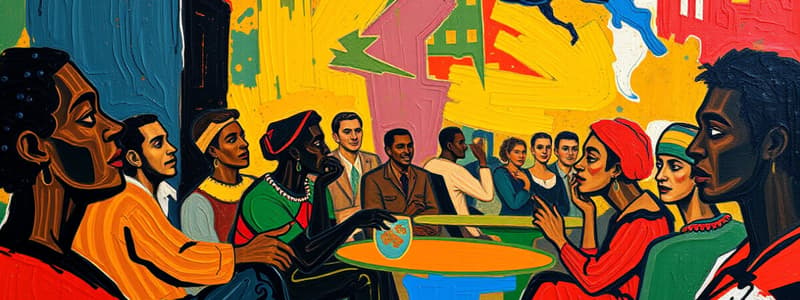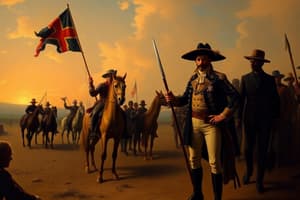Podcast
Questions and Answers
Who was chosen as the Democratic leader at the Baltimore National Convention?
Who was chosen as the Democratic leader at the Baltimore National Convention?
- Henry Clay
- Zachary Taylor
- Martin Van Buren
- Lewis Cass (correct)
What is Popular Sovereignty?
What is Popular Sovereignty?
The concept that a state's people should vote whether to be a slave state or free.
Who was Zachary Taylor?
Who was Zachary Taylor?
A military leader in the Mexican-American War and the 12th president of the United States.
What did the Free Soil Party oppose?
What did the Free Soil Party oppose?
Who won the Election of 1848?
Who won the Election of 1848?
What significant event began on January 24, 1848?
What significant event began on January 24, 1848?
What was the California Constitution's stance on slavery?
What was the California Constitution's stance on slavery?
Who was Harriet Tubman?
Who was Harriet Tubman?
What were Southern grievances before 1850?
What were Southern grievances before 1850?
Who was Henry Clay?
Who was Henry Clay?
What was John C. Calhoun known for?
What was John C. Calhoun known for?
What was the significance of the Seventh of March Speech?
What was the significance of the Seventh of March Speech?
Who was Millard Fillmore?
Who was Millard Fillmore?
What did the Fugitive Slave Law of 1850 entail?
What did the Fugitive Slave Law of 1850 entail?
Franklin Pierce was the Democratic candidate for President in _____?
Franklin Pierce was the Democratic candidate for President in _____?
What was the Ostend Manifesto?
What was the Ostend Manifesto?
What was the Treaty of Wanghia?
What was the Treaty of Wanghia?
Who was Matthew C. Perry?
Who was Matthew C. Perry?
What did the New Republican Party oppose?
What did the New Republican Party oppose?
The _____ line divided free and slave states.
The _____ line divided free and slave states.
Flashcards are hidden until you start studying
Study Notes
Key Figures and Concepts in APUSH Chapter 18
- General Lewis Cass: Democratic leader and veteran of the War of 1812; known for advocating Popular Sovereignty regarding the extension of slavery.
- Popular Sovereignty: Principle allowing states' residents to vote on whether to permit slavery, reflecting democratic ideals but fueling sectional tensions.
- Zachary Taylor: Whig general from the Mexican-American War; became the 12th president but died in office in 1850, succeeded by Millard Fillmore.
- Free Soil Party: Established to oppose slavery in new territories; supported by those favoring the Wilmot Proviso and federal support for internal improvements and homesteads.
- Election of 1848: Featured Zachary Taylor (Whig winner), Martin Van Buren (Free Soil advocate), and Lewis Cass (Democrat); Taylor's presidency ended abruptly with his death.
- Gold Rush of 1848: Triggered by gold discovery at Sutter's Mill; led to an influx of ~300,000 people to California, significantly impacting Westward expansion.
- California Constitution (1849): Urged by Taylor; established California as a free state, intensifying national debates over slavery.
- Harriet Tubman: Former slave who became a leading figure in the Underground Railroad, guiding over 300 enslaved individuals to freedom.
- Southern Grievances: Concerns included potential imbalance of slave vs. free states with California's admission, issues regarding Texas land, and enforcement of the Fugitive Slave Laws.
- Henry Clay: Influential senator known as "The Great Compromiser"; proposed the Compromise of 1850 but passed away before its enactment.
- John C. Calhoun: Advocated for strong enforcement of the Fugitive Slave Law; argued for the necessity of slavery in Southern society.
- Daniel Webster: Whig politician who supported the Compromise of 1850, despite losing favor with his constituents for his perceived betrayal.
- Seventh of March Speech: Webster's call for support of the Compromise of 1850, serving as a pivot point in his political career.
- William H. Seward: Opponent of expanding slavery; articulated a "higher law" philosophy and noted for the "irrepressible conflict" concept between North and South.
- Millard Fillmore: Assumed presidency after Taylor's death and facilitated the passage of the Compromise of 1850, aligning Northern Whigs.
- Nashville Assembly: A meeting of Southern extremists advocating pro-slavery policies and against compromise measures in 1850.
- Fugitive Slave Law of 1850: Aimed to recover runaway slaves; increased tensions between North and South by enforcing strict penalties.
- Personal Liberty Laws: Northern laws created to counter the Fugitive Slave Acts, granting trials to escaped slaves.
- Franklin Pierce: Democrat elected in 1852; known for the Kansas-Nebraska Act and the Gadsden Purchase, which facilitated Southern expansionism.
- Winfield Scott: Respected military general and presidential candidate; created the Anaconda Plan for the Civil War.
- Election of 1852: Resulted in Franklin Pierce's victory amidst the Whig Party's division, leading to the party's decline and rising sectionalism.
- Gadsden Purchase: Acquisition of land from Mexico intended for a southern transcontinental railroad; emphasized the push for expansion.
- Stephen A. Douglas: Key architect of the Kansas-Nebraska Act, promoting popular sovereignty and stoking the slavery debate.
- Kansas-Nebraska Bill: Originated in 1854, allowing the formation of Kansas and Nebraska territories with slavery determined by popular vote.
- Missouri Compromise: Instrumental agreement maintaining the balance of slave and free states; prohibited slavery north of 36˚ 30' in the Louisiana Territory.
- New Republican Party: Emerged from opposition to the Kansas-Nebraska Act; uniting various factions against pro-slavery policies.
- Mason-Dixon Line: Originally a surveying line, it became a symbolic boundary dividing free and slave states during the pre-Civil War era.
Studying That Suits You
Use AI to generate personalized quizzes and flashcards to suit your learning preferences.




